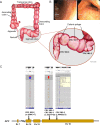The study of Lynch syndrome in a special population reveals a strong founder effect and an unusual mutational mechanism in familial adenomatous polyposis
- PMID: 31924657
- PMCID: PMC7569390
- DOI: 10.1136/gutjnl-2019-320511
The study of Lynch syndrome in a special population reveals a strong founder effect and an unusual mutational mechanism in familial adenomatous polyposis
Keywords: HNPCC syndrome; colorectal cancer; familial adenomatous polyposis.
Conflict of interest statement
Competing interests: None declared.
Figures


Comment on
-
Cancer risk and survival in path_MMR carriers by gene and gender up to 75 years of age: a report from the Prospective Lynch Syndrome Database.Gut. 2018 Jul;67(7):1306-1316. doi: 10.1136/gutjnl-2017-314057. Epub 2017 Jul 28. Gut. 2018. PMID: 28754778 Free PMC article.
References
Publication types
MeSH terms
LinkOut - more resources
Full Text Sources
